

Great Pyramid of Giza. Taj Mahal. The Taj Mahal (/ˈtɑːdʒ məˈhɑːl/ often /ˈtɑːʒ/;,[2] from Persian and Arabic,[3][4] "crown of palaces", pronounced [ˈt̪aːdʒ mɛˈɦɛl]; also "the Taj"[5]) is a white marble mausoleum located in Agra, Uttar Pradesh, India.
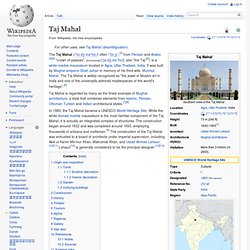
It was built by Mughal emperor Shah Jahan in memory of his third wife, Mumtaz Mahal. The Taj Mahal is widely recognized as "the jewel of Muslim art in India and one of the universally admired masterpieces of the world's heritage".[6] Taj Mahal is regarded by many as the finest example of Mughal architecture, a style that combines elements from Islamic, Persian, Ottoman Turkish and Indian architectural styles.[7][8] In 1983, the Taj Mahal became a UNESCO World Heritage Site.
While the white domed marble mausoleum is the most familiar component of the Taj Mahal, it is actually an integrated complex of structures. Origin and inspiration Taj Mahal site plan. Should guilty seek asylum here, Like one pardoned, he becomes free from sin. Tomb Eastern panaromic view by day Garden. Colosseum. The Colosseum or Coliseum, also known as the Flavian Amphitheatre (Latin: Amphitheatrum Flavium; Italian: Anfiteatro Flavio or Colosseo) is an elliptical amphitheatre in the centre of the city of Rome, Italy.
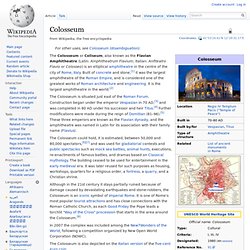
Built of concrete and stone,[1] it was the largest amphitheatre of the Roman Empire, and is considered one of the greatest works of Roman architecture and engineering. It is the largest amphitheatre in the world.[2] The Colosseum could hold, it is estimated, between 50,000 and 80,000 spectators,[6][7] and was used for gladiatorial contests and public spectacles such as mock sea battles, animal hunts, executions, re-enactments of famous battles, and dramas based on Classical mythology. The building ceased to be used for entertainment in the early medieval era.
It was later reused for such purposes as housing, workshops, quarters for a religious order, a fortress, a quarry, and a Christian shrine. Chichen Itza. Chichen Itza (/tʃiːˈtʃɛn iːˈtsɑː/,[1] Spanish: Chichén Itzá [tʃiˈtʃen iˈtsa], from Yucatec Maya: Chi'ch'èen Ìitsha' [tɕʰɨɪʼtɕʼeːn˧˩ iː˧˩tsʰaʲ];[2] "at the mouth of the well of the Itza") was a large pre-Columbian city built by the Maya people of the Post Classic.
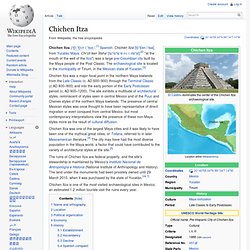
Machu Picchu. Machu Picchu (in hispanicized spelling, Spanish pronunciation: [ˈmatʃu ˈpiktʃu]) or Machu Pikchu (Quechua machu old, old person, pikchu peak; mountain or prominence with a broad base which ends in sharp peaks,[1] "old peak", pronunciation [ˈmɑtʃu ˈpixtʃu]) is a 15th-century Inca site located 2,430 metres (7,970 ft) above sea level.[2][3] It is located in the Cusco Region, Urubamba Province, Machupicchu District in Peru.[4] It is situated on a mountain ridge above the Sacred Valley which is 80 kilometres (50 mi) northwest of Cusco and through which the Urubamba River flows.

Most archaeologists believe that Machu Picchu was built as an estate for the Inca emperor Pachacuti (1438–1472). Christ the Redeemer (statue) Aerial view of the statue The idea of building a large statue atop Corcovado was first suggested in the mid-1850s, when Catholic priest Pedro Maria Boss requested financing from Princess Isabel to build a large religious monument.
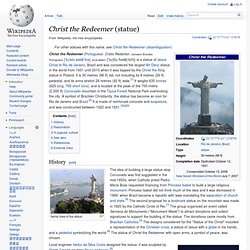
Petra. Petra (Arabic: البتراء, Al-Batrāʾ, Ancient Greek Πέτρα) is a historical and archaeological city in the southern Jordanian governorate of Ma'an that is famous for its rock-cut architecture and water conduit system.
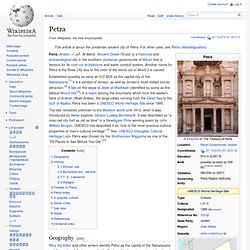
Another name for Petra is the Rose City due to the color of the stone out of which it is carved. The site remained unknown to the Western world until 1812, when it was introduced by Swiss explorer Johann Ludwig Burckhardt. It was described as "a rose-red city half as old as time" in a Newdigate Prize-winning poem by John William Burgon.
UNESCO has described it as "one of the most precious cultural properties of man's cultural heritage".[4] See: UNESCO Intangible Cultural Heritage Lists. Great Wall of China. The Great Wall of China is a series of fortifications made of stone, brick, tamped earth, wood, and other materials, generally built along an east-to-west line across the historical northern borders of China to protect the Chinese states and empires against the raids and invasions of the various nomadic groups of the Eurasian Steppe.
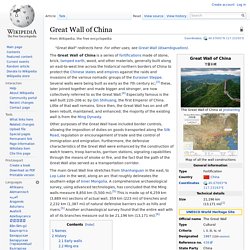
Several walls were being built as early as the 7th century BC;[3] these, later joined together and made bigger and stronger, are now collectively referred to as the Great Wall.[4] Especially famous is the wall built 220–206 BC by Qin Shihuang, the first Emperor of China. Little of that wall remains.